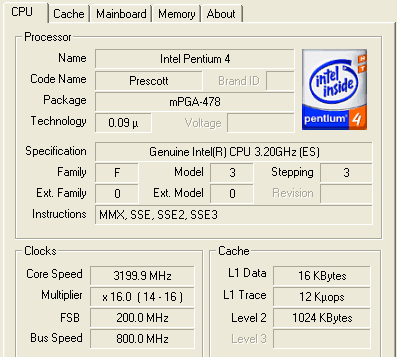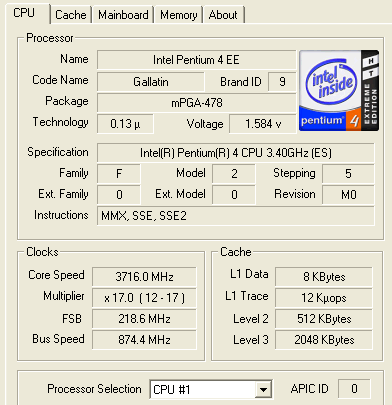System setup and notes
Here's a quick rundown of the test system should you wish to compare benchmark results with your own.Intel Pentium 4 3.2GHz Prescott S478 CPU - 1.4v
Intel Pentium 4 3.4GHz Northwood S478 CPU - 1.6v
Intel Pentium 4 3.4GHz Northwood Extreme Edition S478 CPU - 1.6v
Intel Pentium 4 3.2GHz Northwood Extreme Edition S478 CPU - 1.525v
Intel Pentium 4 3.2GHz Northwood S478 CPU - 1.525v
AMD Athlon 64 Model 3400+ Clawhammer S754 CPU - 2.2GHz
AMD Athlon 64 Model 3200+ Clawhammer S754 CPU - 2.0GHz.
Other components
DFI LANPARTY i865PE with PAT-like BIOS (19/12/2003 BIOS)
EPoX 8HDA3+ VIA K8T880 S754 motherboard (02/12/03 BIOS)
Hercules Radeon 9800XT 256MB (412/730)
IBM 40GB P-ATA hard drive
Toshiba 8x DVD
Samcheer 420w PSU
Dell P991 19" monitor
Zalman 7000Cu S478 / 754 cooler
Software
Windows XP Professional SP1
DirectX9.0b
VIA Hyperion 4.51 drivers
Intel 5.02.1002 chipset drivers
VIA Hyperion 4.51 drivers
ATI CATALYST 4.1 drivers and control panel
Pifast v41 to 10m places
Lame v3.92 MP3 encoding with Razor-Lame 1.15 front-end using U2's Pop album (607MB)
Gordian Knot - XviD encoding test using first vob of Sleepy Hollow. 1433kbit/s bitrate
Kribi Bench 1.19
ScienceMark 2.0
Realstorm Raytracing benchmark 320x180x32
3DMark 2001SE v330
UT2003 Retail (Build 2225)
X2: The Threat - Rolling Demo
Comanche 4 benchmark
Call of Duty HEXUS Custom test
Quake 3 v1.30 HQ
Notes

Notable differences between the Northwood and Prescott are obvious. 1MB of L2 cache, 0.09-micron process technology, SSE3, and 16k L1 data cache. What CPU-Z doesn't tell us is the pipeline length. The CPU installed correctly into a DFI i865PE motherboard running with a PAT-like BIOS. That's Canterwood performance from a supposedly inferior chipset.
It's hot in here
An educated evaluation of the Prescott's architecture would lend weight to the assertion that the Prescott was a cool-running CPU. The ingredients are in place: low voltage and strained silicon between the substrate and transistors should keep it cooler than the equivalent Northwood. Our testing found the opposite to be true. According to DFI's hardware monitoring section, a regular 3.2GHz Northwood, running at 1.525v, was reckoned to hover at around 46c whist being cooled by a Zalman 7000Cu heatsink and 2,400RPM fan. The same setup indicated that the Prescott, running at 1.4v, was idling at around 55c. The Prescott's heatspreader also felt warmer when the heatsink was temporarily removed. We reckon the tight packing of 125-million transistors and the 3.2GHz clock speed aren't conducive to low temperatures. Intel now reckons the 3.4GHz S478 version will, wait for it, dissipate in excess of 100w of heat. Whatever the reasoning, it's one hot CPU. And as every enthusiast knows, heat is overclocking's arch enemy.
We've benchmarked no less than 3 different 3.2GHz Pentium 4s. The Prescott, Northwood and Northwood Extreme Edition. The new 3.4GHz Northwood and 3.4GHz Extreme Edition are also thrown into the melting pot. AMD's excellent Athlon 64 Model 3200+ and 3400+ CPUs complete the lineup bunch.
Even with the apparent heat problems surround the Prescott, we were able to overclock the CPU to 3.7GHz using default (1.4v) voltage. That's with basic air cooling. The same level was reached by the 3.4GHz Extreme Edition and regular Northwood chips, but their default voltage was 0.2v higher.

Time to go benchmarking. Intel lent us a 3.2GHz Prescott 3 weeks before today's launch. It also, in its infinite wisdom, took the CPU away two weeks ago. So while we were able to complete the majority of benchmarks, the two newest additions to the suite, Call of Duty and the revised media encoding test involving the XviD CODEC in conjunction with Gordian Knot were not able to be completed. We'll eendeavourto fill in the missing benchmarks once we have our hands on a retail model.









